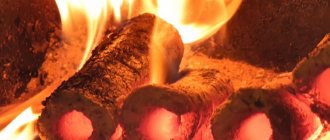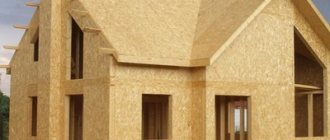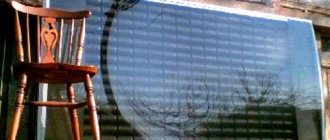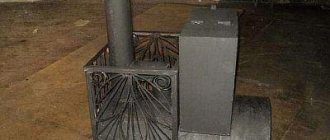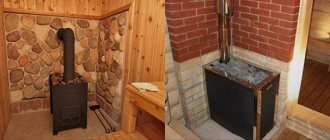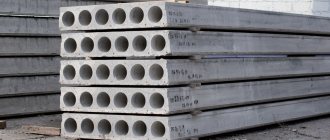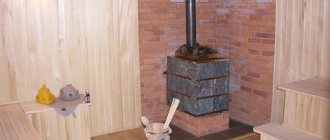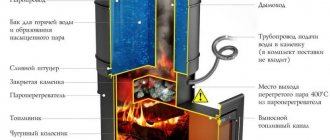If you intend to install a large stove in the house, then this is one situation - here we “squeeze out” everything that is possible and to the fullest extent: a brick stove on a solid foundation and a seriously thought-out and insulated chimney. When it comes to a stove in a bathhouse, the situation here is much simpler and more varied.
Let us at least take into account that the market offers many already developed options for every taste. And the best choice would be to choose a ready-made, proven model. However, you will have to do the maintenance yourself, so it will be necessary to know the structure of the furnace.
Economical sauna stove taking into account all the nuances of use
Sauna stoves: features and characteristics
The bathhouse helps to get rid of negative emotions and is often associated with healthy relaxation, good spirits and a cozy atmosphere. The stove is the heart of the sauna; Comfort, steam quality and safety depend on its characteristics. Choosing the main bath attribute is not so easy; there are too many selection criteria and requirements for it. And if the owner decides to build a bathhouse, he will have to deal with several issues: decide on the material and design of the stove, consider its size and type of fuel.
Today, few people other than professional stove makers know that the method of construction and the principle of operation of a sauna stove differs from the functioning of the stove on which food is prepared. The brick sauna stove is a continuation of the traditions of our ancestors, having the following features:
- Construction . The main parts are: a firebox, a chimney, a grate (a place for fuel) and an ash pan (a chamber where ash accumulates).
Sauna stove with original design Source pinterest.com
- Characteristic . Kamenka, a container for stones, which can be closed or open. The stones are used as a heat accumulator, increasing the time of bathing procedures.
- Weight . Can reach 1000-1200 kg (depending on the size of the stove). For such a massive structure, a reliable foundation is built.
- Fuel . Firewood is used for the firebox, but the stove can operate on both electricity and gas.
Brick sauna stoves are determined by two main parameters:
- Dimensions . The size depends on the area of the premises that are planned to be heated. Most often, there are stoves with a base area of 3.5x4 bricks (890x1020 mm) or 4x5 bricks (1020x1290 mm). If you do not take into account the chimney pipe, the height of the structure is 1680 mm (or 2100 mm if the steam room ceiling is high).
- Construction . Owners prefer to install a model with a water circuit, which serves as a tank for heating water. The tank can have an upper (next to the chimney) or lower (near the firebox) location.
The heater was left in the steam room, the firebox was moved to the dressing room Source sdelaikamin.ru
What to look for when purchasing
When purchasing a heating device, first of all, you need to pay attention to its power. This is a key characteristic that affects performance. To be sure, you can order a calculation of the power of a wood-burning stove for a bathhouse from specialists on the eve of purchase.
In addition, it is equally important to choose the right oven size. If the size of the stove is too large for the room, then it will overheat and fuel will be wasted. The choice of stoves is very large, so it is possible to select the optimal equipment for absolutely any type and size of premises.
Before choosing a stove, you need to find out the area of the potentially heated room and decide on the required set of technical characteristics. Using different models of stoves, it is possible to heat rooms with an area of 80-250 m2.
This type of units, in addition, has two varieties. The first is used exclusively for heating the room. The second model is more functional and, in addition to heating the air, provides the ability to cook food.
The simplest models are very affordable in cost. More complex models with advanced functionality vary in price and can be quite expensive. Therefore, you need to know which features are needed so as not to overpay for unused features.
Advantages and disadvantages of a brick kiln
No matter how profitable and easy to use metal stoves are, owners with worldly experience prefer proven brick structures. A brick sauna stove has the following advantages:
- Heat capacity . The stove is capable of retaining heat for 6-8 hours and heating several rooms (depending on location).
- Energy independence . A wood-burning stove is an ideal option if there is no gas supply and there are power outages.
- Savings during operation . There is no need to install a gas pipe or run wiring and then pay bills. Firewood will cost much less (especially if you prepare it yourself).
- Comfort . Such stoves produce rich, but not scalding (light) steam and soft heat. The atmosphere of the steam room does not make breathing difficult and is ideal for those who like to steam frequently and tastefully.
Compact brick structure Source tproekt.com
- Environmental friendliness . Both the brick from which the stove is made and the firewood are environmentally friendly materials that are safe for health.
- Design . There are real masterpieces of stove art with stunning architecture and design.
- Fire safety . Provided with design features that fully comply with SP 7.13130-2013.
Brick kilns are inferior to other designs due to disadvantages:
- Difficulties in execution . The masonry process has nuances, and it is not easy to find a competent stove maker.
- Size . A large stove eats up precious steam room space.
- Price . The pleasure of making bricks is not cheap: you need to build a foundation, purchase high-quality bricks and pay for the services of a craftsman.
- Time . The stove heats up, and the steam room takes a long time to heat up.
- Care . Systematic cleaning of the ash pan and periodic cleaning of the chimney are required.
A brick stove emits soft heat that is as comfortable as possible for a person. Source tutknow.ru
See also: Catalog of companies that specialize in the installation of fireplaces and stoves.
Chimney
An important part of the stove design is the chimney and connecting pipes. Installation of wood-burning stoves both in houses and in bathhouses requires special care and precision. The process of installing a chimney is especially complicated. Therefore, the features of installing a stove should be thought through at the stage of building houses.
In general, the design of the stove is simple, due to which it operates for the longest possible service life, is easy to repair and is easy to maintain.
Project security
A brick sauna stove needs proper insulation from wooden surfaces - a rule, the violation of which sometimes ends in a fire. For bath procedures to be safe, several conditions must be met:
- Foundation . A reliable foundation is needed, which is arranged according to certain rules.
- Chimney . The pipe passes through the ceiling, ceiling elements and roof. When installing a chimney, it is necessary not only to protect adjacent surfaces from heat, but also to maintain the tightness of the steam room. The pipe is separated from all elements of the building by a gap filled with a layer of fire-resistant material.
- Furnace location . The general rule is that wooden walls should be protected from heat. Therefore, there are minimum permitted distances: between the side surfaces of the stove and the walls - 50 cm, between the combustion door and the opposite wall - 150 cm.
- Isolation . The wall behind the stove is protected by brickwork and metal sheets. A metal sheet (10 mm thick) is placed on the floor in front of the firebox as a protective measure against embers flying out of the flame.
The floor in front of the firebox is insulated with a layer of brick Source kvartal-club.com.ua
Types of construction
Some owners of private residential buildings believe that a heater is a stove made of stones. This is a wrong opinion because they are present in the design only in a certain place. Special stones are loaded into the stove so that they heat up, and when water hits them, steam is formed.
Heaters are usually built from bricks. Metal is also used. Steel options are sold ready-made. They are also manufactured according to individual drawings. Less time is spent on equipping bathhouses with metal models. Most often, the steel version is purchased ready-made and installed in the desired location.
On a note! The metal model is a sauna stove, the dimensions of which are usually smaller than the dimensions of a brick heater.
Options for metal and brick sauna stovesSource obustroeno.com
Materials for the stove: what and how much
Bricks that can withstand repeated temperature changes are suitable for masonry. There are two fairly strong, fire-resistant bricks:
- Fireclay brick . Heat-resistant material of a creamy-yellowish color that can withstand heating up to 1400°C without loss of strength. Such a brick accumulates heat without harm to itself and at the same time has high thermal inertia (slowly heats up and cools down). The parameters are superior to other varieties, but they are also more expensive, which is why they are used mainly for laying out the firebox (20-30 pieces are required).
- Solid red brick marked M (not less than M150). The body, chimney and decorative elements are laid out of it. For a modest structure, 250-280 bricks may be enough; for a large project, 800 (or even 1000) ceramic bricks will be needed.
This fireclay brick will withstand application temperatures up to 1350°C (marking ШБ) Source nsk.zoon.ru
In addition to brick, other materials and tools will be needed:
- Masonry mortar . Consists only of clay and sand. It does not use cement, which crumbles when heated and causes destruction of the masonry over time.
- Furnace casting . Cast iron doors, steel containers for water and stones, a grate (grid), and a view (oven damper) are used.
- Thermal insulator . Any material that can withstand temperatures up to 1200°C is suitable - for example, basalt wool in thin sheets.
- Tools . You will need trowels, a tape measure and a building level.
How to choose the optimal design
In essence, we have already answered this question in the previous chapter, but the answer referred to the specifics of a particular bath.
Let's look at the defining points again:
How to calculate the required volume of container? Assume that one washable item requires at least 10 liters of water.
How are adjacent rooms supposed to be heated? If there are no other options, you can use a remote tank for this purpose. It goes without saying that in this case it should not be thermally insulated. Another option is to use a furnace to heat the antifreeze in a separate heating system.
Are you ready to create forced circulation? If yes, then there are no obstacles to choosing any of the described designs. In this case, you will receive not only a shower, but also, if desired, heating through radiators. True, you will have to organize the system according to all the rules.
We recommend reading:
Construction of a bathhouse from timber
For example, do not forget about the need to install an expansion tank, which absorbs excess fluid in the system.
Kamenka - a feature of the stove for a Russian bath
The main attribute of a bathhouse is often classified according to the heating method:
- The first to appear were stoves that were heated black . They did not have a chimney, and while the logs were burning, the smoke accumulated in the room and stained the walls with soot. Afterwards, the smoke was released through the window, and in order to take a steam bath, you had to wait until the firewood burned completely. Heat and steam were obtained from heated stones lying in the hearth, a prototype of the heater.
- Stoves that burn gray or white have a chimney and a heater in their design. A gray sauna (with an open heater) warms up faster, but soot also accumulates on the stones, and this means that you have to wait until the wood burns out completely.
- In the white sauna, the stove is equipped with a closed heater. It does not pollute the walls of the steam room, does not burn oxygen and carefully preserves heat for a long time. If the steam coming out of an open heater is hard and scalding, here it remains comfortable and soft, even if the thermometer shows 100°C.
Black-style bathhouse, with an open heater Source pechnoy.guru
See also: Catalog of bathhouse projects presented at the “Low-Rise Country” exhibition.
In addition to bricks, other materials and tools will be needed:
- Masonry mortar . Consists only of clay and sand. It does not use cement, which crumbles when heated and causes destruction of the masonry over time.
- Furnace casting . Cast iron doors, steel containers for water and stones, a grate (grid), and a view (oven damper) are used.
- Thermal insulator . Any material that can withstand temperatures up to 1200°C is suitable - for example, basalt wool in thin sheets.
- Tools . You will need trowels, a tape measure and a building level.
Useful properties of steam
It is impossible to imagine a real Russian bathhouse without steam. Steam expands skin pores and removes harmful toxins from the body. The skin becomes more elastic and firm.
Heat dilates blood vessels, stimulating metabolism. The human brain is freed from mental and emotional stress, bringing the entire body into a peaceful state.
The heat of a steam room is an excellent cure for joint disease. It was not for nothing that our ancestors loved going to the bathhouse, mercilessly whipping themselves there with brooms, and to get steam, you would need a sauna heater. Let's figure out how to choose a heater for a bath or make it yourself. Most often, a traditional wood stove is used, although an electric one can be installed.
Kamenka - a feature of the stove for a Russian bath
The main attribute of a bathhouse is often classified according to the heating method:
- The first to appear were stoves that were heated black . They did not have a chimney, and while the logs were burning, the smoke accumulated in the room and stained the walls with soot. Afterwards, the smoke was released through the window, and in order to take a steam bath, you had to wait until the firewood burned completely. Heat and steam were obtained from heated stones lying in the hearth, a prototype of the heater.
- Stoves that burn gray or white have a chimney and a heater in their design. A gray sauna (with an open heater) warms up faster, but soot also accumulates on the stones, and this means that you have to wait until the wood burns out completely.
- In the white sauna, the stove is equipped with a closed heater. It does not pollute the walls of the steam room, does not burn oxygen and carefully preserves heat for a long time. If the steam coming out of an open heater is hard and scalding, here it remains comfortable and soft, even if the thermometer shows 100°C.
Black sauna, with an open heater Source pechnoy.guru
It is convenient to divide sauna stoves according to the heating method:
- Periodic action . Here the stones are on the grate above the flame and have maximum contact with it. Water can only be poured onto the stones after the wood has burned out (otherwise you risk dousing the fire). The stove has to be lit periodically.
- Constant (continuous) action . The stones are in a closed heater (an insulated metal container), which is heated by fire. Heat transfer suffers a little, but you can pour water and heat all the time (constantly), and the soot remains inside and does not pollute the steam room. The stove is lit when there are people in the room; its design prevents combustion products from entering the steam room.
The design of the stove is responsible for generating that famous “light steam”, optimal temperature (70°C) and humidity (60%). Stoves with a closed (internal) heater cope best with this task.
Installation
You can install a wood-burning stove in a bathhouse and even a house yourself, or you can order a service from a company that professionally designs bathhouses, houses and technical premises.
Main working areas:
- fuel loading area;
- ash collection;
- area of combustion of pyrolysis gas.
Installing wood-burning stoves in bathhouses is very popular. They are able to heat the room very quickly and maintain the required temperature for a long time. Even in very cold times, this only takes about half an hour.
At the top of the stove, where the wood smolders, there is an air distributor that regulates the intensity of the flow of fuel to maintain optimal operating conditions. The firewood smolders from above and is also lit from above. This makes it possible to achieve the release of pyrolysis gases, which are also capable of burning and releasing heat. This operating mechanism allows you to obtain additional heat from one volume of fuel.
Video description
About the stove with a water tank in the following video:
Of course, a stove with a pile of stones on top looks much more impressive and produces excellent steam. In fact, an open heater is more suitable for a Finnish sauna, with its high temperature and dry air (Finns pour little water). High temperatures and high humidity can cause heart problems in an unprepared person. The main benefit of an open heater (as well as a metal stove) is the rapid heating of the room.
Suitable pipe sizes
Steel pipe as the main raw material for the furnace has a number of advantages. Among them:
- resistance to damage;
- good level of heat transfer;
- rapid heating of the room;
- minimal expansion when heated;
- use of any type of fuel;
- minimum number of welds.
The disadvantages of a metal stove are the same rapid cooling of the room as heating, uneven distribution of heat in the room. To eliminate them, the stove is often lined with bricks.
530 mm
For a steam room of standard sizes, a pipe measuring 530 millimeters is good. A stove made from it will be quite powerful; the wood will burn for a long time, providing good performance. Available in horizontal and vertical versions.
640 mm
A good material option for a large steam room in a bath complex. The large firebox allows you to place a lot of firewood at once, increasing the break between loads to 8 hours.
426 mm
This diameter is enough for a small steam room in a seasonal building, where bathing procedures are combined with washing or dousing with cold water in one room.
It is important to note that cast pipes without seams are an excellent option for small furnace parts; their diameter does not exceed 250 mm. To make the main part of the furnace, it is better to take pieces of spiral pipes - they are reliable and will cost the same as scrap metal. If you can’t find these, you should take straight-seam ones.
Construction of a brick sauna stove: sequence of work
Each brick sauna stove is a piece production product. Regardless of which configuration is chosen, the stove is built according to the established order, from the foundation to the chimney and finishing. The main task is to ensure that it does not smoke and effectively heats the steam room.
Planning
The stove design (size and configuration features) is selected in advance, simultaneously with the preparation of the bathhouse design. After choosing a project, an order is drawn up - a plan that shows the layout of bricks separately for each layer (row).
An example of the arrangement (diagram) of a brick oven with a bottom placement of the water tank Source banya-expert.com
Video description
About the detailed process of laying a heater in the following video:
Masonry
When the clay mortar is ready, start laying. It is recommended to start with the construction of a brick wall that protects the adjacent wall from critical heating. The laying of bath stoves is carried out in compliance with the following rules:
- Before starting work, stock up on a printed order .
- The bricks are laid according to plan ; Castings are inserted as needed.
- Experienced stove makers prefer to lay each row first “dry” , without mortar. This preliminary fitting significantly improves the process and allows you to avoid difficult mistakes. The method makes it possible to accurately select bricks and try on castings.
- Formation of the first row . An important stage on which the geometry of the furnace depends. At the end of the row, check the corners.
- Laying out the body . The second row (and subsequent ones) are laid offset so that each seam falls in the middle of the brick from the previous row. This staggered arrangement ensures the reliability of the design.
Fireclay bricks are used for laying the firebox Source tproekt.com
About Kuznetsov's sauna stove
The team led by Igor Viktorovich Kuznetsov developed a fundamentally new design of a furnace with a two-tier bell - a chamber in which heating occurs (in the lower bell) and separation of the movement of hot and cold gases (in the upper bell). Hot gases are retained in the furnace, which significantly increases the heat transfer of the structure.
Kuznetsov’s brick stove can maintain a suitable temperature not only in the steam room, but also in the washing room and in the rest room. High efficiency, economical fuel consumption and a minimal amount of soot during combustion contribute to the popularity of the design.
Fragment of brick oven masonry Source bazar.bg
Chimney installation
Wood-burning stoves are often used in saunas. The simplicity of the design makes it possible to assemble and install such a stove with your own hands. But it is very important to pay due attention to the installation of the chimney. Only with proper organization of the chimney can you be sure of fire safety.
Problems with chimneys of long-burning stoves arise due to their high efficiency. All the heat is transferred to the room, rather than going out into the chimney. In this case, the burnt gases condense on the inner walls of the pipe and flow down. This condensate, at the slightest cracks at the joints of pipes, can escape to their outer side, which leads to the appearance of an unpleasant odor and spoils the appearance of the device. To avoid such problems, at the design stage of houses and baths, all the features of the premises and the internal architecture of the space are taken into account to create the optimal shape and design of the chimney.
Brick oven: cladding features
Brick stoves are suitable for cladding like no other, since brick and cladding have approximately the same coefficient of thermal expansion, which cannot be said about a metal structure. The brick oven heats up gradually, and the lining has time to warm up evenly. The most popular facing materials are:
- Clinker tiles . Clinker is characterized by high refractoriness and heat capacity; it does not deform over time and gives a cozy appearance to the steam room. During production, dyes and fireclay clay are mixed into clinker.
- Terracotta . Pressed unglazed clay that has been fired. The tile has a characteristic red-brown color and excellent strength indicators.
The fashion for tiles spread in the 17th and 18th centuries and has remained in demand to this day Source forumhouse.ru
- Majolica . Tile material obtained by pressing; an improved version of terracotta. A colored design is applied to the tiles and covered with glaze.
- Tile (a type of tile). Special box-shaped tiles, often handmade, decorated with a sophisticated pattern and filled with glaze, were originally invented for lining stoves. The tiles have a special design on the back side and are fastened with special metal pins into the seams, simultaneously with the stove masonry.

